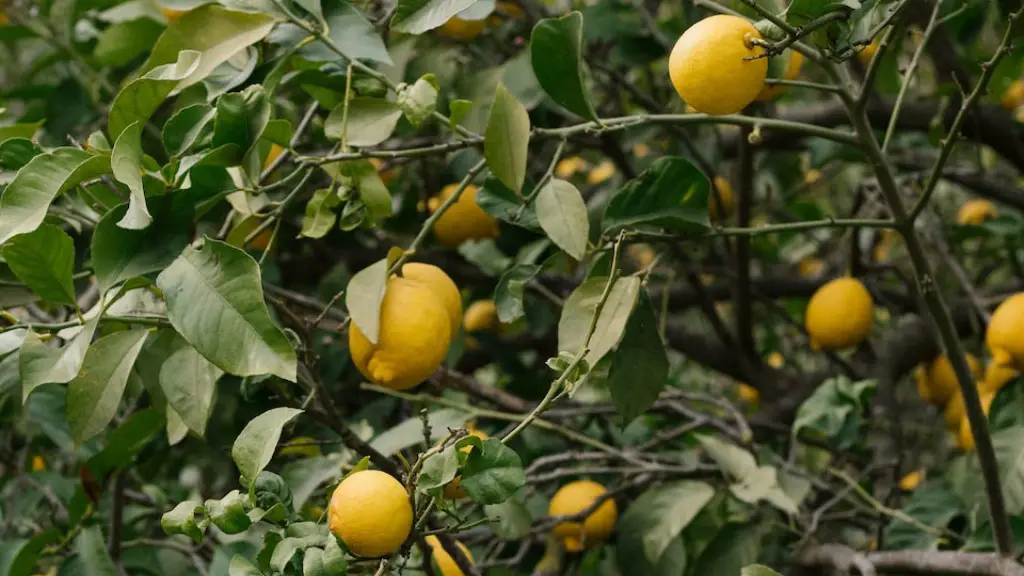Lemon trees are among the most widely cultivated fruit trees in the citrus family. Though they take longer than many other types of fruit trees to develop, lemon tree can take three to five years to reach full maturity. Knowing how long it takes for a lemon tree to mature is essential for gardeners and orchard owners who hope to produce an abundant, sweet harvest.
The length of time it takes for a lemon tree to fruit depends greatly on the age and health of the tree and the soil it is planted in. Usually, it will take between three and five years for a lemon tree to produce a harvest worthy of consumption. If planted in the soil with the proper vitamins and nutrients, the time to maturity may be much shorter.
The key to harvesting a bountiful lemon crop lies in the level of care provided. The lemon tree must be given ample sunlight, water, and fertilizer. During the three to five years before the tree begins to fruit, it must also be pruned periodically to maintain its size and shape. Mulching can help to ensure that the soil remains nourished and provides essential nutrients to the growing tree.
Temperature is also an important factor in determining how long it takes for a lemon tree to mature. If grown in an area with warmer than average temperatures, a lemon tree may reach maturity in as little as two years. Alternatively, cooler climates may add an extra year or two to the maturity time-frame.
Contrary to popular belief, harvesting lemon fruit prematurely will not necessarily improve the speed at which the tree matures. In fact, it is best to wait until the fruit is fully ripe and golden in color before it is picked, as harvesting prematurely can stunt the tree’s growth.
Those who are patient with their lemon tree will be rewarded with a plentiful and regular bounty of sweet, juicy lemons for many years to come. Understanding the needs of the tree, and the conditions that it requires for thriving, is key for anyone seeking a successful lemon yield.
Different species, such as Meyer lemons or ‘Eureka’ lemons, may have a slightly different growth time and size, but on average, it can take three to five years for any lemon tree to mature and produce fruit. Providing the tree with the proper environment and care will ensure that this timeline is fulfilled.
How To Care For The Lemon Tree?
Proper nutrition and light exposure are essential in the growth of any fruit tree, and lemon trees are no different. During the three to five-year growth period, the tree should receive a generous supply of sun and fertilizer. Mulch can be an effective way to retain moisture in the soil and reduce the need for regular watering. Thinning can also help to improve airflow and prevent the formation of fungus.
Fertilizer should be applied at least every two months, while water should be provided on a daily basis. If the soil is allowed to become dry, the growth rate of the tree will be slowed and it is likely to produce lesser yields. As the tree matures, pruning will be necessary to ensure healthy growth and retain the overall shape of the tree. Proper pruning techniques can help the tree grow smoothly without any drawbacks.
Identifying potential pest issues is also an important part of caring for a lemon tree. Inspect the tree every few weeks for signs of insects, and apply suitable insecticides if necessary. Planting companion plants such as basil near the tree can help to reduce the risk of disease, as some herbs have natural insect repellent properties.
With continued care, a lemon tree can provide a bountiful harvest of sweet, plump, and juicy lemons. Regular and thorough nurturing of the tree will ensure its optimal growth, and eventually a satisfying yield of the golden citrus.
Diseases And Pests
Though ensuring proper care and nutrition can help, lemon trees can sometimes become subject to diseases and pests. One of the most common issues is root rot, a fungal infection caused by having overly moist soil. If the tree is showing signs of stunted growth, or browning and rotting of the roots, it may be infected with root rot, and the affected parts must be treated with a fungicide.
Some fungal diseases can cause yellow or brown patches on the leaves, in which case a copper or sulfur-based fungicide can be applied. Insects such as aphids, whiteflies, scales, or mealybugs can also act as carriers for fungal diseases, and should also be treated with insecticides. Another disease that affects citrus trees is citrus canker, a bacterial infection characterized by circular lesions on the leaves. Treatment of citrus canker typically involves pruning infected leaves, then treating the wound with a sharp blade.
It is important to remain vigilant when nurturing a lemon tree, as many diseases and pests can cause serious damage if left untreated.Always be on the lookout for any signs of illness or disease,and take necessary action if any are present.
Harvesting Ways
Once the lemon tree has matured enough, it will produce an abundant crop of golden lemons. Knowing precisely when to pick the fruit is key to harvesting a successful crop. Generally, it is best to wait until the lemons are golden in color, or at least until the fruit is fully grown and has a slight give when squeezed. Once removed, store the fruits in single layers to prevent bruising.
On the other hand, if the fruits are left on the tree for too long, they may spoil and rot, so careful observation is key in timing the harvest. To speed up the ripening process, lemons can be placed in an airy paper bag to absorb the ethylene gas they release. Covering the fruit with straw or using a ripening tray can also be effective.
For many lemon tree aficionados, learning to identify ripe lemons and harvesting them at the right time can be a rewarding experience. With regular practice, it is likely that the lemon harvest will be of sufficient quality and quantity.
Preservation
Once picked, lemon fruits can be preserved for use at a future date. To retard ripening, the fruit can be stored in a container filled with a solution of water and lemon juice. Alternatively, lemons can be stored in bags in the refrigerator, or even frozen to keep them fresh for longer.
If the lemons are to be stored in the freezer, they must first be cooled and scrubbed clean, as freezer burn can be a common issue. Then, each lemon must be wrapped tightly in cling wrap, before being placed in a sealable bag. The lemons can be stored in the freezer till needed, and should remain good for up to a year.
Another way to store lemon fruits is to make homemade lemon juice or lemonade. The juice can be frozen for later use in a variety of dishes, smoothies, and drinks. To make the lemonade, simply dilute the juice with water, sugar and other flavorings. The lemonade can also be stored in the refrigerator for up to ten days or frozen for later use.
Preservation techniques such as these help to ensure that the lemon harvest can be enjoyed at any time of the year. Choosing an ideal method for storing and preserving the fruits will allow for a longer shelf-life and delicious lemon treats for months to come.



